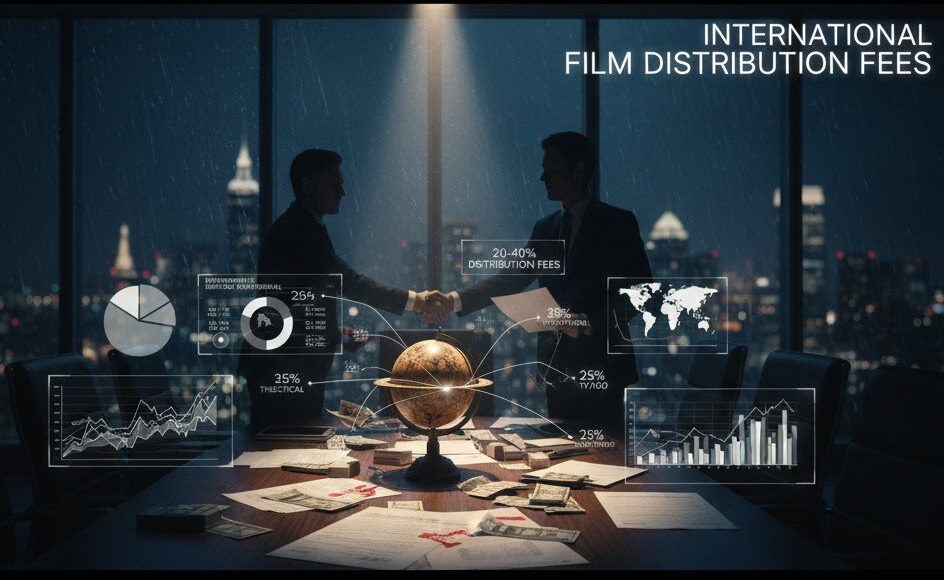Introduction
The film industry, while steeped in creative tradition, is undergoing a seismic shift driven by rapid advancements in technology. From how films are sold to how they reach global audiences, the role of technology in film distribution is no longer a futuristic concept but a present-day reality. Forward-thinking producers, distributors, and sales agents are increasingly embracing data-driven film sales strategies to gain a competitive edge.
This article explores the transformative impact of innovations like AI in film sales, the dominance of streaming platforms film distribution models, the power of VOD analytics for film, and the rise of online film marketplaces. We’ll also touch upon how platforms like Vitrina are providing crucial insights, making Vitrina AI for film sales a valuable consideration for industry professionals.
Table of content
- Introduction
- Key-Takeaways
- The Technological Revolution in Film Distribution
- Data-Driven Decision Making: The New Norm in Film Sales
- Artificial Intelligence (AI): Its Emerging Role in Film Sales and Distribution
- Online Film Marketplaces and the Future of Deal-Making
- Vitrina AI: Navigating the New Technological Landscape
- Conclusion
- FAQs
Key Takeaways
| Tech/Data Aspect | Core Impact |
|---|---|
| Streaming Platforms | Dominant force in distribution, offering global reach but also complex data ecosystems and content demands. |
| Data Analytics | Enables more informed decisions on content valuation, audience targeting, marketing spend, and distribution strategy. Key for data-driven film sales. |
| AI in Film | Emerging applications in content discovery, audience prediction, automated metadata tagging, and potentially deal-making. |
| Online Marketplaces | New platforms facilitating direct connections between filmmakers/rights holders and distributors/buyers. |
| Vitrina AI’s Role | Provides centralized market intelligence, helping stakeholders navigate global content availability, buyer activity, and platform needs. |
Want to Leverage AI and Data for Better Film Sales?

The Technological Revolution in Film Distribution

The ways films are bought, sold, and consumed have been fundamentally altered by technology in film distribution. The shift from physical prints to digital delivery, the explosion of on-demand viewing, and the global connectivity offered by the internet have created both immense opportunities and new challenges for the industry. Understanding these technological underpinnings is crucial for anyone involved in getting films to audiences today. The rise of streaming platforms film distribution models is perhaps the most visible aspect of this revolution, but the changes run much deeper.
From physical prints to digital delivery: The evolution.
Not long ago, film distribution meant physically shipping heavy film prints to cinemas around the world. Today:
- Digital Cinema Packages (DCPs): Are the standard for theatrical exhibition, allowing for easier, cheaper, and higher-quality delivery.
- Cloud-Based Delivery: Increasingly used for transferring master files to distributors, broadcasters, and VOD platforms globally, speeding up workflows.
- Direct-to-Consumer (DTC) Platforms: Enable filmmakers and rights holders to bypass traditional intermediaries and offer content directly via their own apps or websites.
This digital transition has lowered some barriers to entry but also requires new technical expertise and infrastructure.
The rise of streaming platforms and their impact on traditional models.
Streaming platforms film distribution has become a dominant force, profoundly impacting traditional release windows and business models:
- Global Reach: Services like Netflix, Amazon Prime Video, and Disney+ have amassed hundreds of millions of subscribers worldwide, offering unprecedented reach for acquired and original content.
- Content Demand: These platforms have an insatiable appetite for diverse content, creating new sales opportunities for films of all types.
- Windowing Disruption: Streaming has led to compressed theatrical windows, day-and-date releases, and straight-to-streaming premieres, challenging long-held industry norms.
- Data Control: Streamers possess vast amounts of viewership data, which they use to inform their content acquisition and production decisions, often keeping this data proprietary.
Traditional distributors and broadcasters are adapting by launching their own streaming services or partnering with existing ones.
Impact of VOD (SVOD, AVOD, TVOD) on sales strategies.
The various Video on Demand models each influence sales strategies differently:
- SVOD (Subscription): Deals often involve significant license fees for exclusive rights, making these platforms attractive targets for premium content.
- AVOD (Advertising-supported): Offers broader reach and revenue-sharing opportunities, becoming a key channel for library content and some exclusive programming.
- TVOD (Transactional): Provides an early “home entertainment” window for new releases, allowing for premium pricing for rentals or digital purchases.
A modern film sales strategy must consider the optimal mix and timing of these VOD windows alongside any theatrical or TV plans. Understanding VOD analytics for film, where available, can help optimize these strategies.
| Technological Shift | Impact on Distribution | Example |
|---|---|---|
| Digital Delivery (DCPs, Cloud) | Faster, cheaper, higher quality delivery to exhibitors/platforms. | Sending a DCP to a cinema via satellite or hard drive. |
| Rise of Global Streaming Platforms | New major buyers, global audience access, window disruption. | A film premiering worldwide as a Netflix Original. |
| Growth of AVOD Services | Increased demand for library content, ad-based revenue models. | An older film finding a new audience on Tubi. |
This technological evolution is continuously reshaping how technology in film distribution influences the entire value chain.
Data-Driven Decision Making: The New Norm in Film Sales
Gut instinct and personal relationships have always played a role in the film industry, but today, they are increasingly being augmented – and sometimes superseded – by data. The move towards data-driven film sales and distribution strategies is one of the most significant impacts of technology in film distribution. By analyzing various data points, stakeholders can make more informed decisions about which films to acquire, how to market them, and where to distribute them for optimal results. Access to and interpretation of VOD analytics for film and other market data are becoming key differentiators.
Types of data influencing film acquisition and distribution.
A wide range of data can inform decisions:
- Audience Viewing Data: (Often held by platforms) What are people watching? How long do they watch? What do they watch next? Completion rates.
- Social Media Analytics: Buzz around a film, sentiment analysis, audience demographics and interests.
- Box Office Data & Comparables: Performance of similar films in various markets.
- Market Trend Data: Which genres are popular in specific territories? What are the content needs of different platforms?
- Demographic Data: Understanding the makeup and preferences of target audiences.
- Search Trend Data: What types of content are people actively looking for online?
How VOD analytics for film and audience insights shape strategy.
VOD analytics for film, when accessible, provide powerful insights:
- Content Performance: Which films are driving subscriptions or engagement on a platform? This influences future acquisitions.
- Audience Segmentation: Understanding different viewer segments and their preferences allows for more targeted content recommendations and marketing.
- Churn Prediction: Identifying content that helps retain subscribers.
- Marketing Effectiveness: Analyzing which promotional efforts drive views or conversions.
While platforms often keep their most detailed analytics proprietary, distributors and filmmakers can still leverage publicly available data, third-party analytics services, and insights from platforms like Vitrina to inform their strategies.
The shift towards predictive analysis in content valuation and marketing.
The industry is moving towards using data not just to understand past performance but to predict future success:
- Predictive Content Valuation: Algorithms that analyze script elements, cast, genre, and market data to forecast a film’s potential box office or streaming performance.
- Targeted Marketing: Using data to identify and reach the most receptive audience segments with personalized marketing messages.
- Optimizing Release Strategies: Data can help determine the best release dates, windowing strategies, and distribution channels for a particular film.
This embrace of data-driven film sales aims to reduce risk and maximize ROI in an increasingly competitive market.
| Data Type | Application in Sales/Distribution | Benefit |
|---|---|---|
| Audience Viewing Data (from platforms) | Inform acquisition strategy, content recommendations. | Better alignment of content with viewer preferences. |
| Social Media Analytics | Gauge audience sentiment, identify influencers, target marketing. | More effective and efficient marketing spend. |
| Comparable Film Performance Data | Estimate market potential, inform sales expectations. | More realistic financial projections and deal-making. |
| Market Trend Data (e.g., from Vitrina) | Identify in-demand genres/themes, discover buyer needs. | Strategic positioning of film for current market. |
Data is becoming an indispensable tool for navigating modern technology in film distribution.
Artificial Intelligence (AI): Its Emerging Role in Film Sales and Distribution
Artificial Intelligence (AI) is rapidly moving from a buzzword to a tangible force with the potential to further revolutionize technology in film distribution and sales. While still in its earlier stages of adoption in this specific domain, AI in film sales and distribution promises to enhance efficiency, provide deeper insights, and potentially automate certain processes. From content discovery to audience prediction, AI tools are beginning to offer new capabilities to industry professionals engaged in data-driven film sales.
Current and potential applications of AI in the film value chain.
AI is being explored for various applications, including:
- Content Analysis & Metadata Tagging: AI can analyze scripts or video content to automatically generate detailed metadata (e.g., genre, themes, keywords, sentiment, object recognition). This aids in content discovery and catalog management.
- Audience Preference Prediction: AI algorithms can analyze vast datasets of viewing behavior to predict what types of content specific audience segments will enjoy, informing acquisition and greenlighting decisions.
- Personalized Recommendations: Powering the sophisticated recommendation engines on streaming platforms.
- Automated Content Summarization/Trailer Creation: AI tools are being developed to create rough cuts of trailers or summaries, speeding up marketing workflows.
- Predictive Box Office/Streaming Performance: AI models that attempt to forecast a film’s commercial success based on various inputs.
- Rights Management & Royalty Tracking: Potential for AI to help manage complex rights agreements and automate royalty calculations.
AI for content discovery, audience prediction, and targeted marketing.
Three key areas where AI in film sales and distribution is showing promise:
- Enhanced Content Discovery: For buyers, AI can help sift through vast libraries of available films to find projects that match their specific acquisition criteria more efficiently. For consumers, AI powers the “you might also like” features.
- More Accurate Audience Prediction: By analyzing past viewing patterns and demographic data, AI can help predict which audiences are most likely to respond to a particular film, enabling more targeted distribution strategies.
- Hyper-Targeted Marketing: AI allows for the creation of highly specific audience segments for advertising campaigns, optimizing marketing spend and increasing conversion rates.
Ethical considerations and the future of AI in decision-making.
While AI offers exciting possibilities, there are also important considerations:
- Bias in Algorithms: AI models are trained on data, and if that data reflects existing biases, the AI can perpetuate or even amplify them (e.g., in content recommendations or funding decisions).
- Over-Reliance on Data: The risk of undervaluing unique, groundbreaking films that don’t fit existing patterns if decisions become purely data-driven. Human curation and creative instinct remain vital.
- Transparency and Explainability: Understanding how AI models arrive at their conclusions is important for trust and accountability.
- Job Displacement: Concerns about AI automating tasks currently performed by humans.
The future will likely involve a symbiotic relationship, where AI augments human expertise in film sales and distribution rather than completely replacing it. Understanding the capabilities and limitations of AI in film sales will be crucial.
| AI Application | Potential Benefit | Consideration |
|---|---|---|
| Automated Metadata Tagging | Improved content searchability and organization. | Accuracy and nuance of AI-generated tags. |
| Audience Preference Prediction | Better alignment of content with target viewers. | Risk of creating echo chambers or missing outlier hits. |
| Predictive Performance Analysis | Aid in content valuation and greenlighting. | Models are still evolving; human judgment remains key. |
| Personalized Marketing | More efficient ad spend and higher engagement. | Data privacy concerns, potential for intrusive targeting. |
The role of AI in film sales is set to grow, adding another layer to technology in film distribution.
Ready to Navigate the Future of Film Distribution?

Online Film Marketplaces and the Future of Deal-Making
Another significant impact of technology in film distribution is the emergence of online film marketplaces. These digital platforms aim to streamline the process of buying and selling film rights by connecting filmmakers and rights holders directly with distributors, broadcasters, and streaming services from around the world. While traditional physical film markets remain important, these online platforms offer new efficiencies and accessibility for data-driven film sales and deal-making.
The rise of digital platforms for licensing and selling film rights.
Online film marketplaces typically offer features such as:
- Project Listings: Filmmakers/sales agents can upload details about their available films (synopsis, trailer, screener, rights availability).
- Buyer Profiles: Distributors and platforms can create profiles outlining their acquisition needs and territories of interest.
- Search and Discovery Tools: Allowing buyers to easily search for content based on genre, budget, rights, etc., and sellers to find relevant buyers.
- Secure Screening Rooms: For buyers to watch films online.
- Communication Tools: Facilitating direct messaging and negotiation between parties.
- Deal Management: Some platforms offer tools to help manage offers, contracts, and even payments.
These platforms aim to make the initial discovery and connection process more efficient.
Benefits and limitations of virtual film markets and B2B platforms.
Benefits:
- Increased Accessibility: Lower cost and logistical barriers to entry compared to attending multiple physical markets, especially for independent filmmakers or smaller companies.
- Global Reach: Connect with buyers and sellers from anywhere in the world, 24/7.
- Efficiency: Faster to search for content or buyers than browsing a physical market floor.
- Data Availability: Some platforms provide analytics on views, interest, etc.
Limitations:
- Less Face-to-Face Interaction: The crucial element of personal relationship-building that happens at physical markets can be diminished.
- Curation and Discovery Challenges: With potentially vast numbers of listings, standing out can still be difficult.
- Varying Quality and Legitimacy: The quality of listings and the seriousness of buyers/sellers can vary across different platforms.
- Deal Complexity: While initial connections can be made, complex deal negotiations often still require more direct interaction or legal oversight.
Many see online film marketplaces as complementary to, rather than a complete replacement for, physical markets.
How these platforms are changing the dynamics of film sales.
Online marketplaces are influencing film sales by:
- Democratizing Access: Providing more opportunities for lesser-known filmmakers to get their projects in front of potential buyers.
- Speeding Up Discovery: Allowing buyers to quickly identify films that meet their criteria.
- Facilitating Niche Sales: Making it easier to find buyers for specialized or genre content.
- Potentially Reducing Costs: Lowering travel and market attendance expenses for some.
As these platforms mature and integrate more sophisticated tools (perhaps incorporating more AI in film sales for matchmaking), their role in the overall film sales and distribution ecosystem is likely to grow.
| Online Marketplace Feature | Advantage | Potential Challenge |
|---|---|---|
| Global Project Listings | Wider visibility for films beyond physical markets. | Risk of getting lost in a crowded digital space. |
| Advanced Search for Buyers | Efficiently find content matching acquisition needs. | Ensuring buyer profiles are up-to-date and accurate. |
| Lower Cost of Participation | More accessible for indie filmmakers/small companies. | Reduced opportunities for in-person networking. |
| Direct Communication Tools | Streamlines initial contact and discussion. | Complex negotiations may still require offline interaction. |
These platforms represent an exciting evolution in technology in film distribution.
Vitrina AI: Navigating the New Technological Landscape
In an era where technology in film distribution and data-driven film sales are paramount, having a reliable source of comprehensive market intelligence is crucial. Vitrina positions itself as a key partner for industry professionals seeking to navigate this evolving landscape. By providing centralized data, analytics, and connectivity, Vitrina AI for film sales support aims to empower producers, distributors, and sales agents to make more informed and strategic decisions.
How Vitrina centralizes data for smarter sales and distribution.
Vitrina’s platform is designed to address the challenge of fragmented information in the global content market. It helps by:
- Aggregating Global Content Availability: Tracking which films are available on which platforms (including streaming platforms film distribution data) and in which territories.
- Monitoring Buyer and Seller Activity: Providing insights into who is acquiring what, recent deals, and company content strategies. (Vitrina’s Project Tracker can offer visibility into upcoming projects and market interest).
- Analyzing Platform Needs: Helping users understand the content requirements and programming strategies of various VOD services and broadcasters.
- Facilitating Connections: Offering a directory and discovery tools to find potential partners, from distributors to sales agents to production companies worldwide.
This centralized approach saves time and provides a broader market overview than might be achievable through manual research alone.
Using Vitrina AI for film sales to identify opportunities and trends.
For those focused on data-driven film sales, Vitrina’s AI-powered insights can help to:
- Spot Emerging Trends: Identify which genres, themes, or types of content are gaining traction in specific markets or on particular platforms.
- Uncover Niche Opportunities: Find underserved markets or platforms that might be a good fit for specialized content.
- Benchmark and Valuate (Contextually): While not providing direct financial valuations, understanding where similar content is placed and by whom can give context for sales expectations.
- Optimize Market Strategy: Inform decisions about which film markets to attend and which buyers to target based on their current activity and stated needs.
By harnessing these insights, users can refine their sales pitches and distribution plans for greater effectiveness.
The future of industry intelligence platforms in film.
As technology in film distribution continues to evolve, the need for sophisticated industry intelligence platforms like Vitrina’s solution will only grow. Future developments may include:
- More Advanced Predictive Analytics: Deeper integration of AI in film sales to forecast demand and potential performance with greater accuracy.
- Enhanced Personalization: Tailoring insights and recommendations even more closely to individual user needs and content portfolios.
- Streamlined Deal-Making Integrations: Potentially connecting intelligence with transactional capabilities or online film marketplaces.
- Richer VOD Analytics for Film: Greater transparency (where permissible) into viewership data to help rights holders understand content performance.
Platforms that can provide clear, actionable intelligence in a rapidly changing technological environment will be invaluable partners for the film industry.
| Vitrina AI Capability | Benefit for Film Professionals |
|---|---|
| Global Content & Buyer Database | Efficiently find sales leads and distribution partners worldwide. |
| Market Trend Analysis | Make informed decisions based on current content demand. |
| Platform Catalog Monitoring | Identify opportunities with specific streaming services. |
| Competitor Activity Tracking | Understand the strategies of other players in the market. |
Vitrina AI for film sales and distribution aims to be a vital tool in this tech-driven era.
Conclusion
The infusion of technology in film distribution and the rise of data-driven film sales are undeniably reshaping how movies find their way from creators to global audiences. From the transformative power of streaming platforms film distribution and the nuanced insights from VOD analytics for film, to the emerging potential of AI in film sales and the convenience of online film marketplaces, the industry is in a constant state of evolution. For producers, distributors, and sales agents willing to adapt and leverage these new tools – including intelligence platforms like Vitrina – the future offers exciting possibilities for more efficient, targeted, and ultimately successful film sales and distribution strategies worldwide. The key is to combine human expertise and creative vision with the power of technology and data.
Ready to harness the power of data for your film sales and distribution efforts? Explore Vitrina to see how our AI-driven insights can help you navigate the modern technological landscape and achieve greater success.
Frequently Asked Questions
Currently, AI in film sales is most effective in areas like advanced content discovery (helping buyers find relevant films faster), audience segmentation for targeted marketing, and analyzing large datasets to identify broad market trends. Predictive performance analytics are still evolving but show promise.
Not entirely. Online film marketplaces offer convenience and accessibility, especially for initial discovery and smaller deals. However, traditional physical markets like Cannes, EFM, and AFM remain crucial for high-level networking, relationship-building, and closing major international deals. Many see them as complementary.
Direct access to detailed VOD analytics for film performance on major platforms (like Netflix) is often limited for independent filmmakers, as platforms tend to keep this data proprietary. However, distributors who license films to these platforms may receive some performance data. Filmmakers using aggregators for TVOD platforms might get sales reports. Social media analytics and website traffic can also provide indirect audience insights.
One of the biggest challenges is accessing comprehensive, reliable, and unbiased data, especially granular viewership data from major streaming platforms. Another is having the expertise to correctly interpret the data and translate it into actionable strategies. There’s also the risk of over-relying on data and stifling creativity or ignoring outlier potential.
For a comprehensive roadmap to film sales and distribution, check out our complete guide here: The Essential Guide to Film Sales and Distribution in the Modern Era: From Strategy to Global Reach.






































